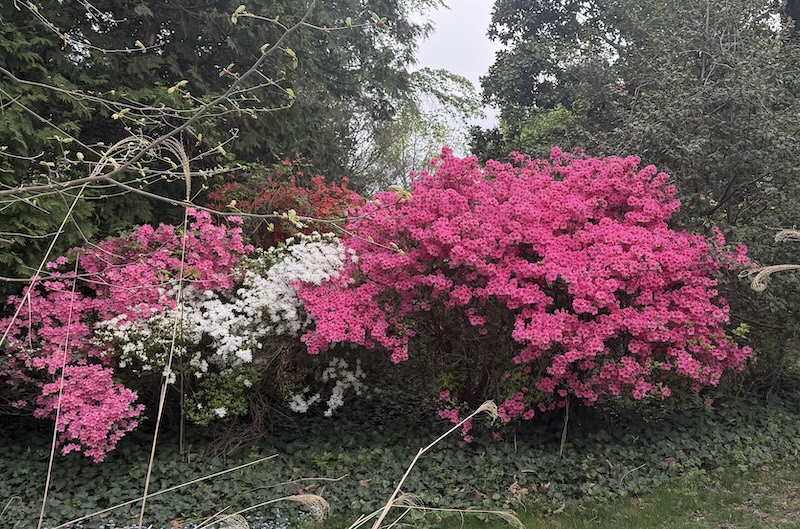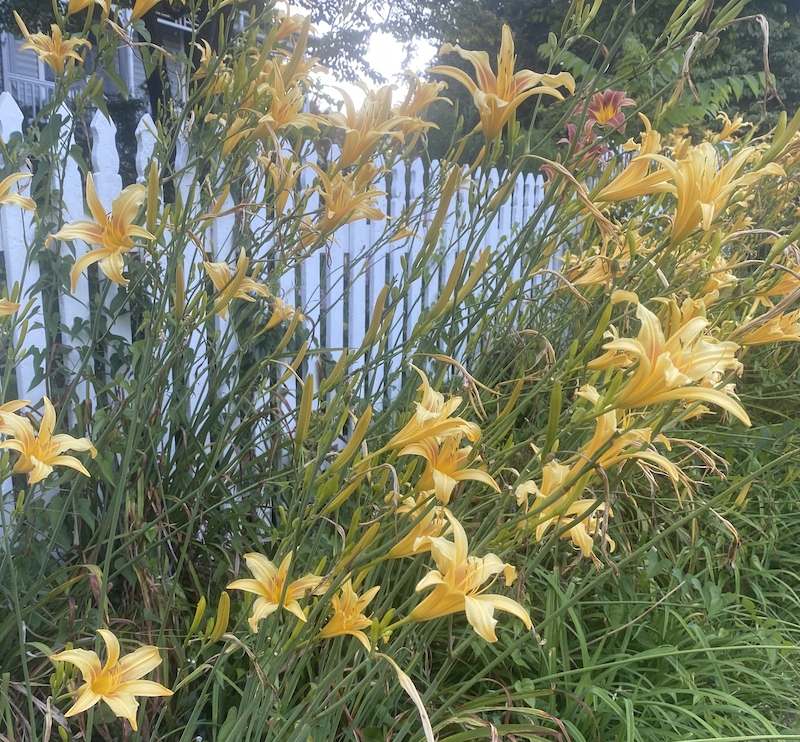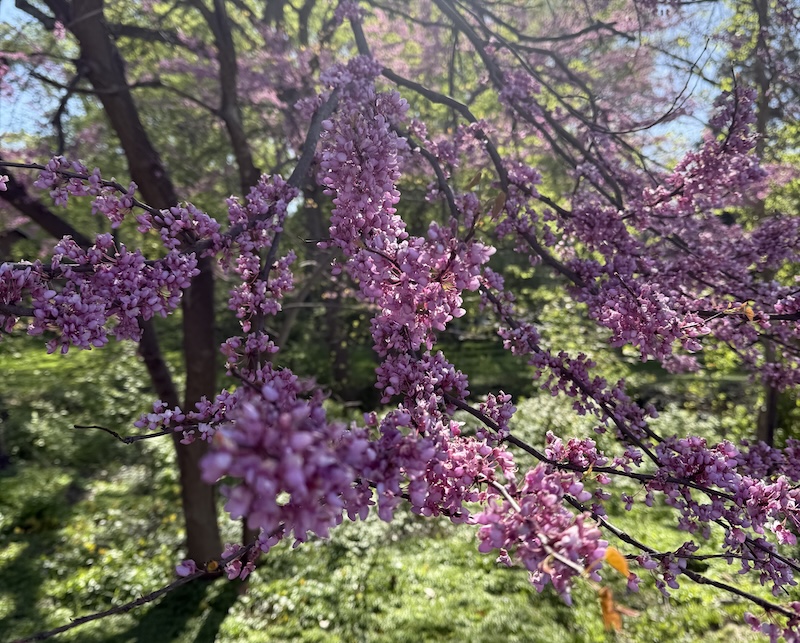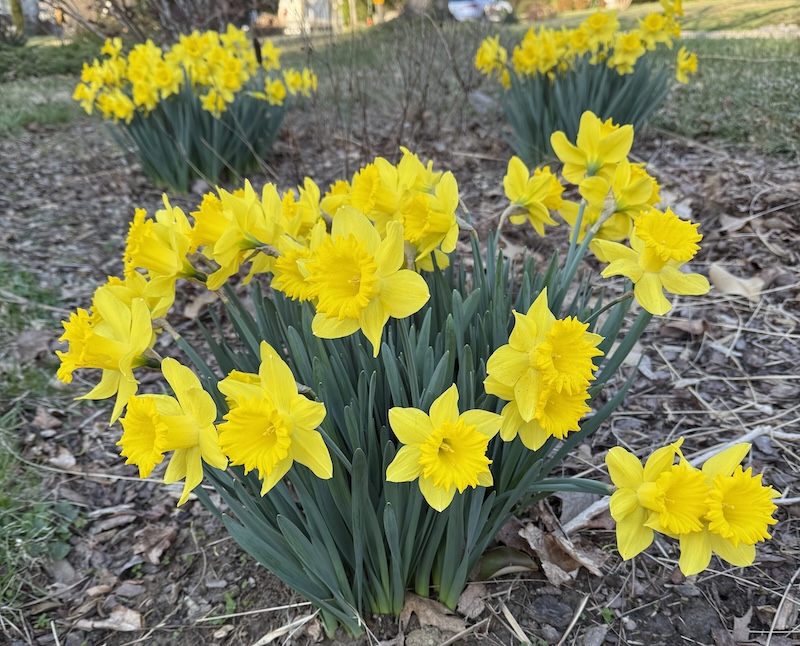Though April showers may come your way, They bring the flowers that bloom in May,
So if it’s raining have no regrets, Because it isn’t raining rain you know, it’s raining violets.
– Al Jolson

April was a month of activity in the garden, and our old nemesis, weeds are beginning to rear their heads, so we need to extract the little devils before they take hold and are difficult to remove.

Having said that, I must point out the benefits of many weeds. Nettles are food for butterflies, clover extracts nitrogen from the air, which is then absorbed into the soil and the oil from jewel weed soothes poison ivy rash. The young foliage of Dandelions is great in salads and when lightly cooked it tastes like spinach with the added advantage of containing many healthy nutrients.
In this group, I do not want to forget our songbirds and other wildlife who depend on weed seeds as a food source.
WEED REMOVAL
Weeds must be pulled gently so that the weeds and roots do not break apart, because if this happens, thousands of weed seeds will reseed and you will find yourself with an endless cycle of unnecessary weeding. When careful weeding has been accomplished, apply an organic weed pre-emergent, with a corn gluten base by Bradfield Organics; this natural product will keep weeds at bay for about six weeks.
ROSES, RHODODENDRONS & MORE

Plant bare root roses at the end of April or beginning of May and plant container roses in mid- May. In the middle of May when the soil temperature has reached 55 degrees, add manure and on top of the manure add a fine bark mulch about one foot from the base of the roses. Check my Early Spring tips to remind yourself on pruning roses.
Be careful clearing winter debris from around rhododendrons, mountain laurel and azaleas; these evergreens have shallow roots and do not appreciate having their roots exposed. If winter weather did erode soil around some roots, add soil to cover the exposed roots and at the same time resettle the plant in place. In the middle of May apply manure and fine bark mulch as well as some peat, which adds much needed acidity for evergreens.
Plant Gladioli corms at two-week intervals in late April. Planting in two- week intervals ensure you will get a succession of bloom. Plant the corms eight inches below the surface; this extra depth helps to keep the heavy blooms erect.
The Red Lily beetle will soon appear, and I suggest applying organic Neem oil on the Lilies when they are about four inches above ground, the oil helps to halt this beetle problem.
SOIL SOLARIZATION & MULCHING
This is an effective way to control many soil-borne problems, specifically the tomato blight that causes fruit rot. Covering the soil with clear plastic in the area where tomatoes are to be planted at the end of April, for one to two months can generate high enough temperatures in the top six to 12 inches of soil to kill pests, nematodes, weed seeds and many disease organisms like the tomato blight. This process has proved invaluable for home gardeners and the beneficial effects last for several seasons.
To solarize, dig a trench several inches deep around the soil bed, and spread a thin, clear plastic film (1-4mils) over the bed. Press the plastic into close contact with the soil and seal the edges by filling the trench with soil. Leave the plastic on the soil until you are ready to plant tomatoes or other vegetables in about six weeks.
With a soil thermometer checking to see when the soil temperature has reached 55 degrees, then manure all the borders with composted manure in bags from the garden center or aged manure from the bottom of the farmer’s pile, then mulch with a fine brown hardwood mulch. It is important to wait until the soil temperature has reached 55 degrees so that the valuable bacteria in the manure can work its magic in the soil.

In the vegetable garden, following soil preparation and planting, it is time to mulch. Mulch with composted manure that will not ‘cap,’ which means it does not form a crust like other mulches and air and water can penetrate through to the roots of the plants where it is needed for vegetable and fruit production.
If you did not apply an organic grub control on the grass in March, apply now to reduce the grubs, which is the food source for Moles; the grub control will help to cut down on the mole population.
Soil is the most important component of production in the garden; with compost, organic manure and peat to amend soil and rebuild its structure. The ratio to use is one part compost to three parts manure and apply peat to the planting mix in the ratio of one part peat to three parts manure when planting evergreens. And as mentioned above, peat adds the acidity which evergreens require.
Good soil structure assists with drainage, prevents compaction, and the rich nutrients with the amendments break down and encourage the soil animals beneath the surface to work at full capacity. In a sandy soil, humus is needed to produce micronutrients for this soil, which is the combination of manure, mulch and carbon from the atmosphere that binds the sand particles together which will produce a healthy workable soil. In heavy soil such as clay, the humus separates the clay particles which allow for air and drainage.
GROWING CONDITIONS IN LATE APRIL/EARLY MAY
These are very favorable for new plant-root development. This month is the best time to transplant evergreen shrubs and plant new evergreens. Apply composted manure and peat together with the topsoil in the planting hole. Then give the roots a workout with your hands before planting. Separating the roots in this way gives them the freedom to reach into the surrounding soil for nutrients and water remaining moist in the heat of summer.
Many years ago, when I moved into my farmhouse on the shoreline, I discovered that my soil was sandy, which is good for drainage but sadly lacking in nutrients. I began adding a few inches of manure to all planted borders in April, July and October. The result today is when I put a spade in the ground to check the color of the soil in spring it’s ‘black gold’.
Gloves should be worn when handling manure, as manure contains bacteria; the bacteria is great for the plants and the soil but not good for your health. These natural soil amendments tend to be slow acting; gradually making the nutrients available to the plants throughout the season with infinite rewards.. Composted manure is applied in spring around mid May when the soil temperature has reached 55 degrees and when the plants show about six inches of growth. This method allows the nutrients and soil animals to become active at the time when plant growth is occurring at a rapid pace.
DAFFODILS, FROSTS & ANNUALS

Daffodils, which are my favorite flower, are appearing in gardens and on roadways making a lovely spring time sight. When the Daffodil bloom has past, do not cut the leaves from the Daffodils or any of your spring flowering bulbs, the leaves send down energy in the form of food into the bulbs to store for next season’s growth.
This is the time to tackle a new lawn or patch seed, use only good quality grass seed, organic fertilizers and lime, which provide the alkaline, need for healthy grass growth.
Even after several consecutive warm days, frost can still occur. Having said that I suggest that you do not plant annuals until Memorial weekend. If you purchase annuals at the Mother’s Day sales, place the annual plants in a protected spot in the garden, like a wall, until planting. Do not cultivate around the perennials in the borders until mid May.
Do not panic if you are not able to get the April tasks done until May, your garden will wait for you and the constancy that is Mother Nature will continue to keep your patch of earth flourishing.
Enjoy the pleasure of being outdoors in warmer temperatures, inhaling the pungency of awakening soil and your connection with Mother Nature. Do not overdo it; warm up the body before the garden labor and stay well hydrated with lots of water.
We are inexorably entwined with the earth and know that even the smallest gesture of a garden has positive rewards; the effects are not only on you but on our planet.
It is important to have a well-thought-out plan before creating a new garden or landscape. Yo may wish to call my son Ian, who has followed in my footsteps as a landscape designer, and arrange a landscape consultation at LandscapesByIan.com
I will see you in your garden with more gardening tips later in May and if you have any gardening questions, please email MaureenHaseleyJones@gmail.com
About the author: Maureen Haseley-Jones is a member of a family of renowned horticultural artisans, whose landscaping heritage dates back to the 17th century. She is one of the founders, together with her son Ian, of, The English Lady Landscape and Home Company. Maureen and Ian are landscape designers and garden experts, who believe that everyone deserves to live in an eco-conscious environment and enjoy the pleasure that it brings. Maureen learned her design skills from both her mother and grandmother, and honed her horticultural and construction skills while working in the family nursery and landscape business in the U.K. Her formal horticultural training was undertaken at the Royal Botanic Gardens at Kew in Surrey.